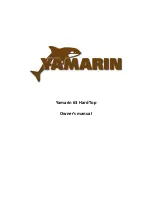
Take the end of the block and tackle line to the cockpit.
Take 3 wraps clockwise around the jib winch on the star-
board side (the right side when facing forward), insert the
winch handle securely in the winch and begin cranking up
the mast. The loads will be heavy at first, but lighten as the
mast goes up.
Look around to make sure all mast wires are clear and free
of tangles. Again, make sure you are clear of all overhead
power lines and that the mast won’t hit them when it goes
up or when you have to move the trailer after the mast is up.
Look up at the rig to make sure that none of the loops in the
wire ends are kinked or hooked over the stainless steel fit-
tings to which the wires attach.
All of the comments in the previous section still apply to
raising the mast. The optional system simply reduces the
physical effort involved in the mast lifting.
Don’t stand under the mast or under the mast raising pole. If
something lets go, or the mast falls, these are not the places
to be.
When the mast is up, pull the rope tight, and tie the line
securely to the winch. Don’t use the cam cleat near the winch
to secure the line. These are not that secure. It is one thing
for a sail to get loose, quite another for the mast to fall down.
Now connect the bottom end of the forestay turnbuckle to
the forward hole in the stainless steel fitting at the nose of
the boat. Don’t release tension on the mast raising line until
the forestay is secure and the clevis pin is secure.
Make sure all the pins are securely in place and the cotter
pins are opened and secured. Tighten down on the turnbuckle
so the rig is snug. Secure it with its cotter pins. One nice
thing about this setup is that you will not have to adjust the
turnbuckle after it is once set. The pulleys provide suffi-
cient power to stretch the rig enough to remove the pin. (This
is the only disconnect that you have to make for raising and
lowering the mast.)
To lower the mast, reverse the process used for either the
standard or optional system. Once again, watch for power
lines. Before you lower it, put the wooden mast support in
its holders in the cockpit. Otherwise the mast will come down
on the cabin hatch and maybe mar the finish.
Remember, the load gets greater as the mast gets lower. Be
prepared. Get a good grip on the line or the mast and don’t
be fooled by the very small loads while the mast is close to
the up position. With the optional mast raising system, it is
best to snub the line around the winch to take some of the
load off of you.
We leave you with one repeat warning. People have been
killed or badly injured as a result of masts or support wires
coming into contact with overhead power lines. Be watch-
ful whenever you rig, launch, trailer or do anything else with
your boat that might involve contact with power lines. If
there is a threatening power line anywhere near areas where
you sail, call or write to the power company and try to get
them to move it or bury it. Notify us and we will also lean
on them. Don’t remove the warning sticker on the mast. The
repeated warnings may get boring, but power lines are life
threatening risks.
11. ADJUSTING THE MAST SUPPORT WIRES
MAST RAKE:
The mast, when set properly, should lean about 3 degrees to
the rear of the boat from vertical.
When properly tuned, all of the mast support wires should
be quite snug. Use the following sequence to set the rig-
ging.
REAR SUPPORT WIRE: (BACKSTAY)
Adjust the rear mast support wire to give the mast the proper
fore and aft position.
FORWARD SUPPORT WIRE (FORESTAY)
Take up the slack in the forward mast support wire by ad-
justing the turnbuckle. At this point, tighten it enough to
give a slight forward bend to the center of the mast.
TOP SIDE SUPPORT WIRE: (UPPER SHROUD)
Adjust the top side mast support wires so that the mast is
straight from side to side. Try to make them snug. Note: The
wire adjuster channels are designed as “verniers” to provide
adjustments in 1/8" increments. This is accomplished by
having the holes in the wire straps spaced at different inter-
vals than the holes in the adjuster channels. As the wire is
extended every 1/8", a new set of holes will line up, allow-
ing very precise tuning adjustments. A small screwdriver
can be inserted in one of the sets of non-aligning holes to
provide leverage to get tension on the wires while the clevis
pin is being inserted in the proper holes. Use the 1/4" clevis
pins and cotter rings to connect the channels to the straps
fastened to the support wires.
These channels are stronger than turnbuckles, better able to
stand the bending loads resulting from raising and lowering
the mast, and less likely to accidently come loose.
MIDDLE SIDE SUPPORT WIRES: (LOWER
SHROUDS)
Adjust the middle side support wires as described above.
Don’t get them too tight or the center of the mast will be
pulled toward the rear of the boat.
Summary of Contents for 26
Page 13: ......








































